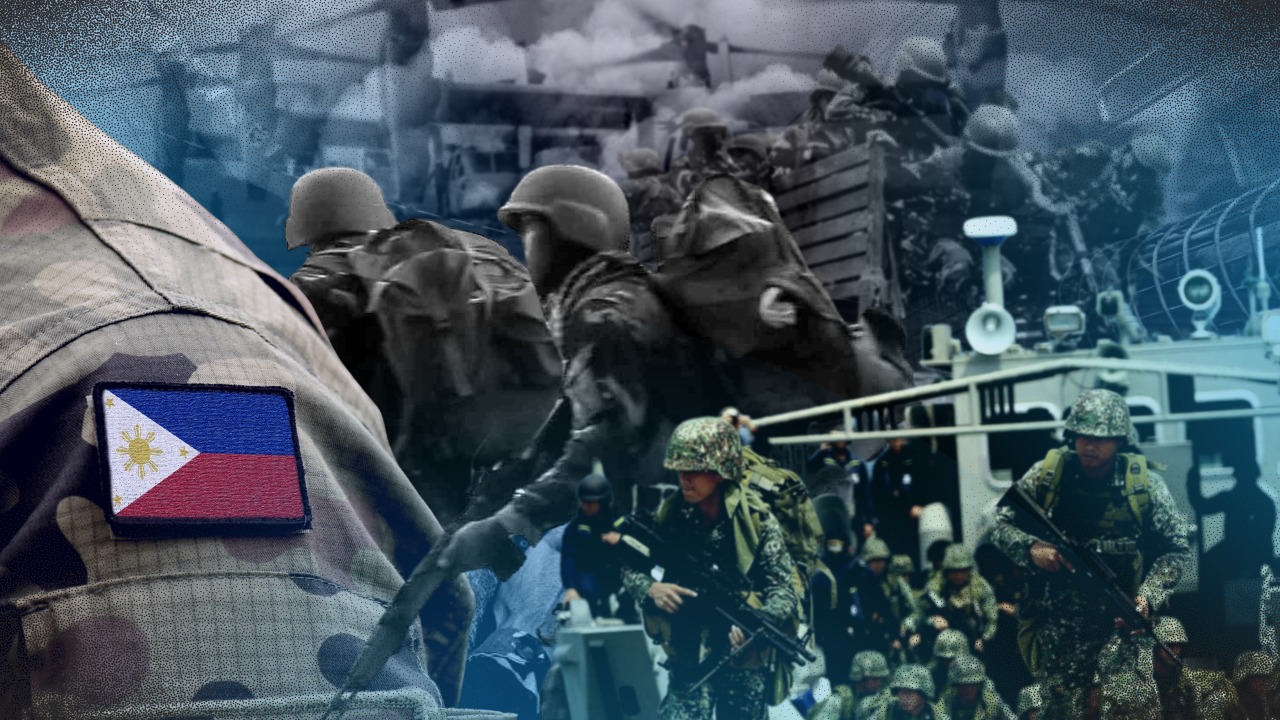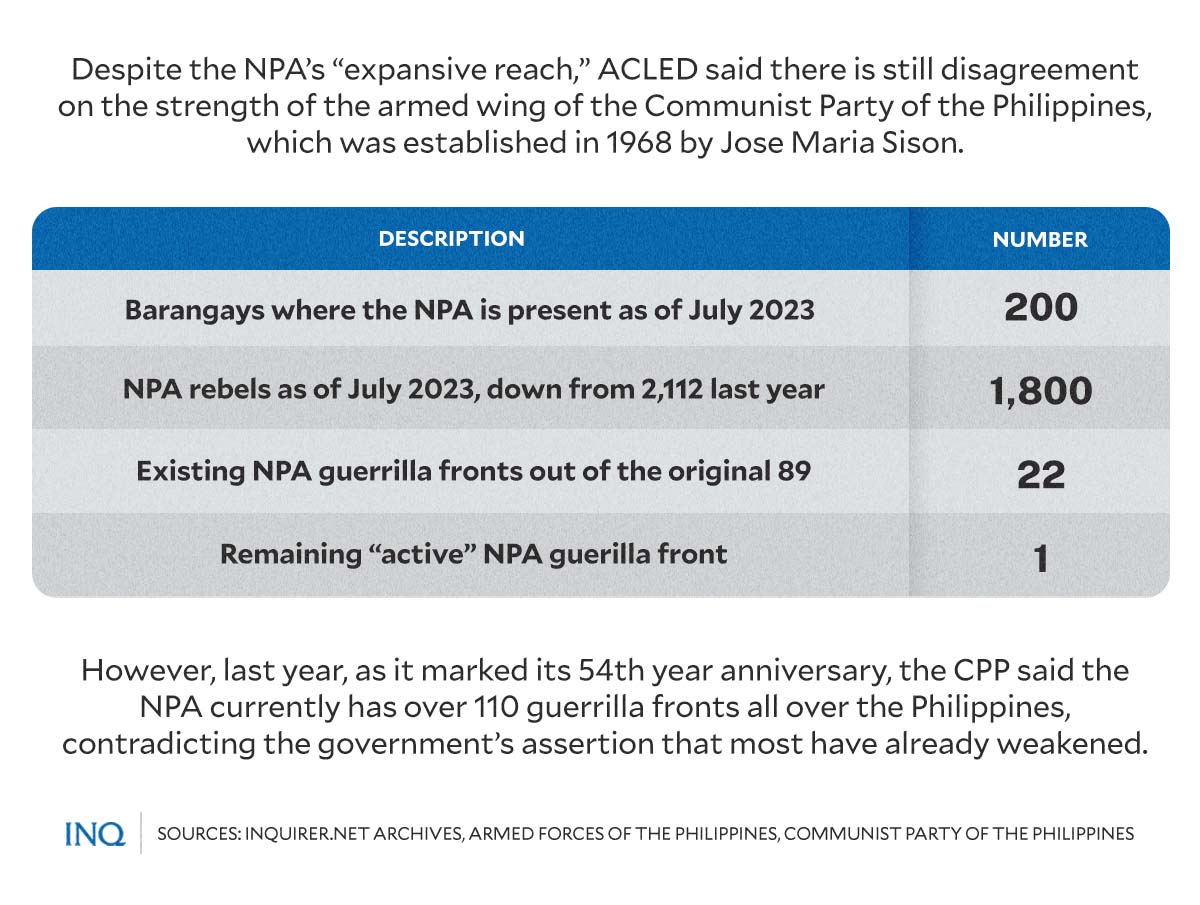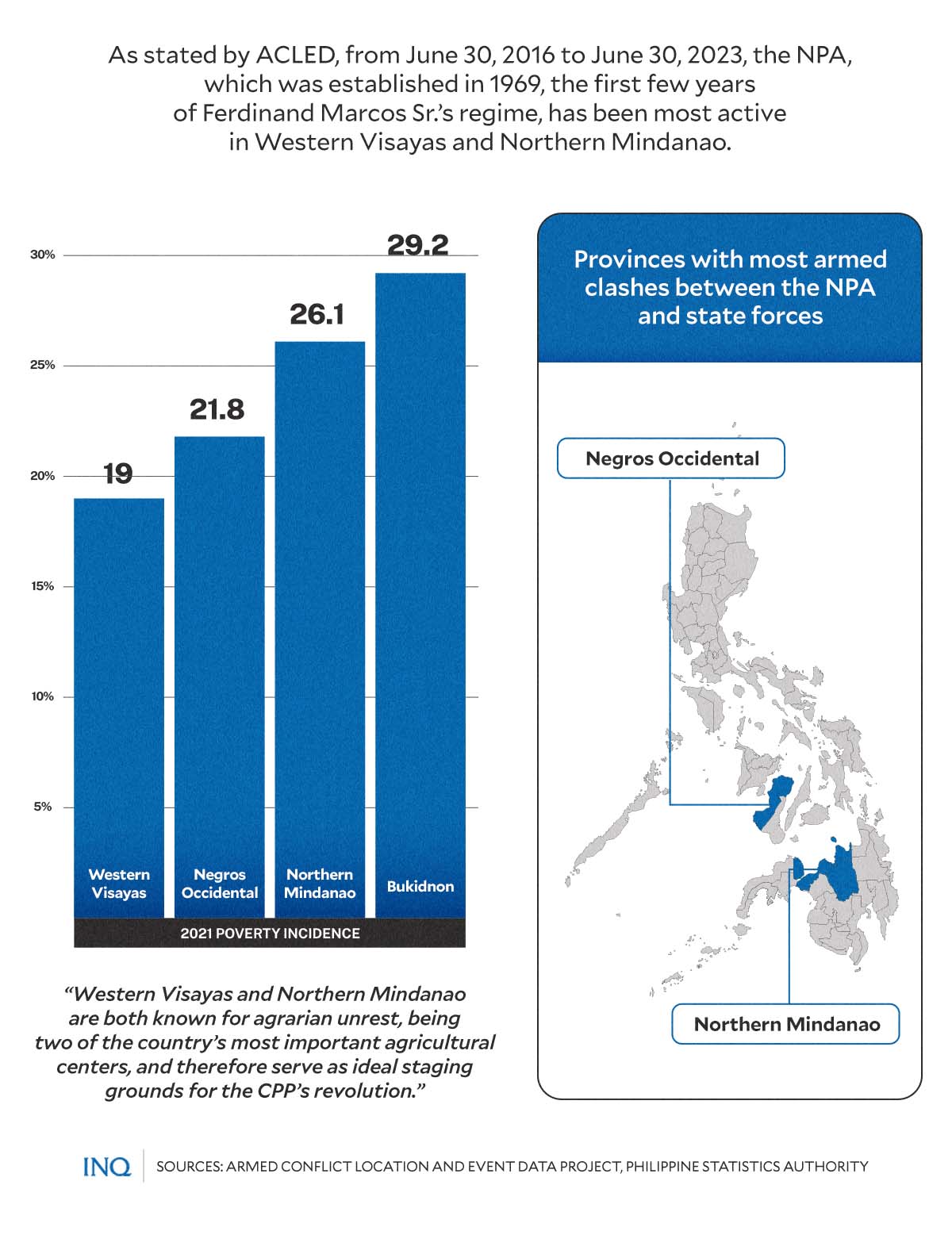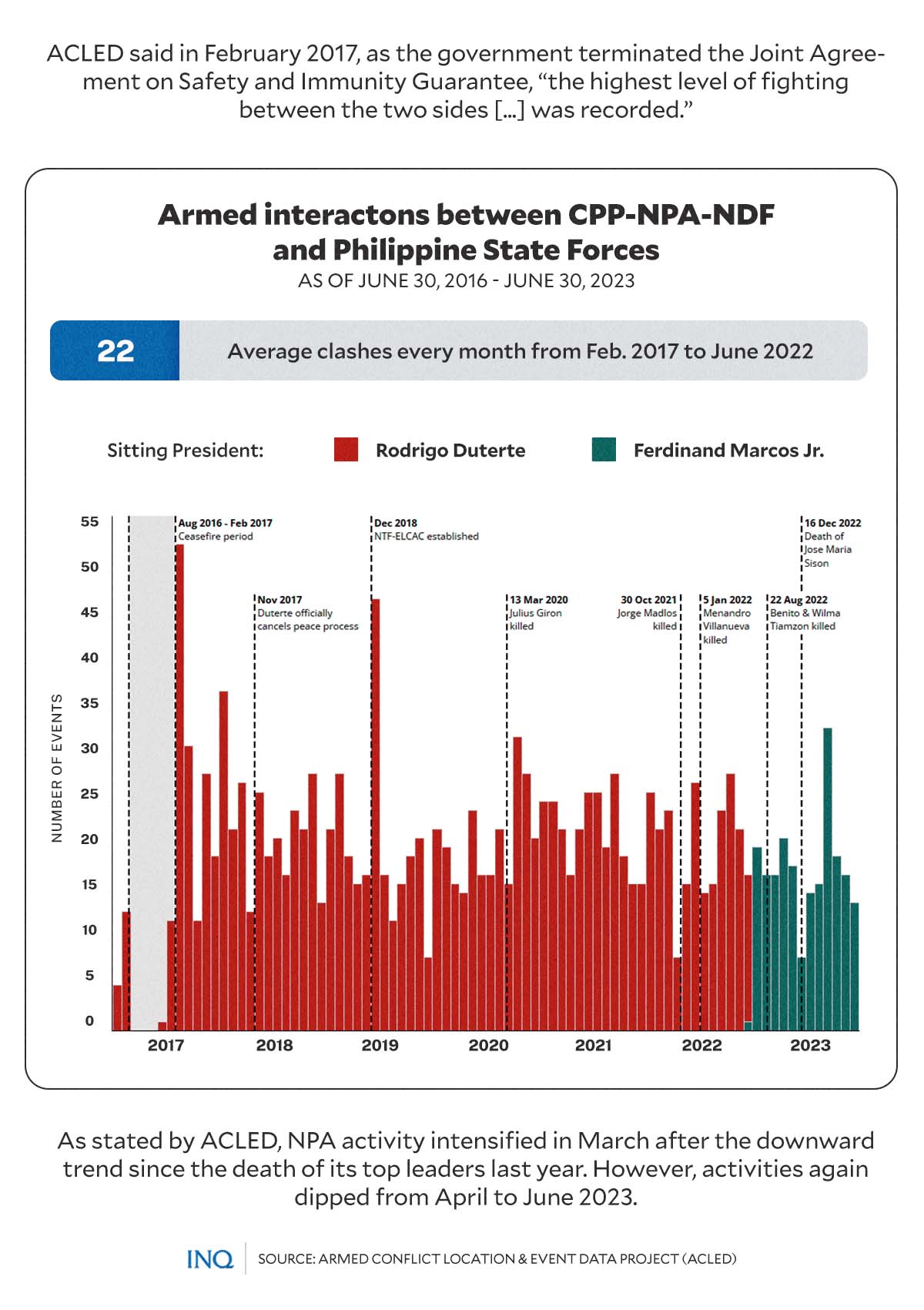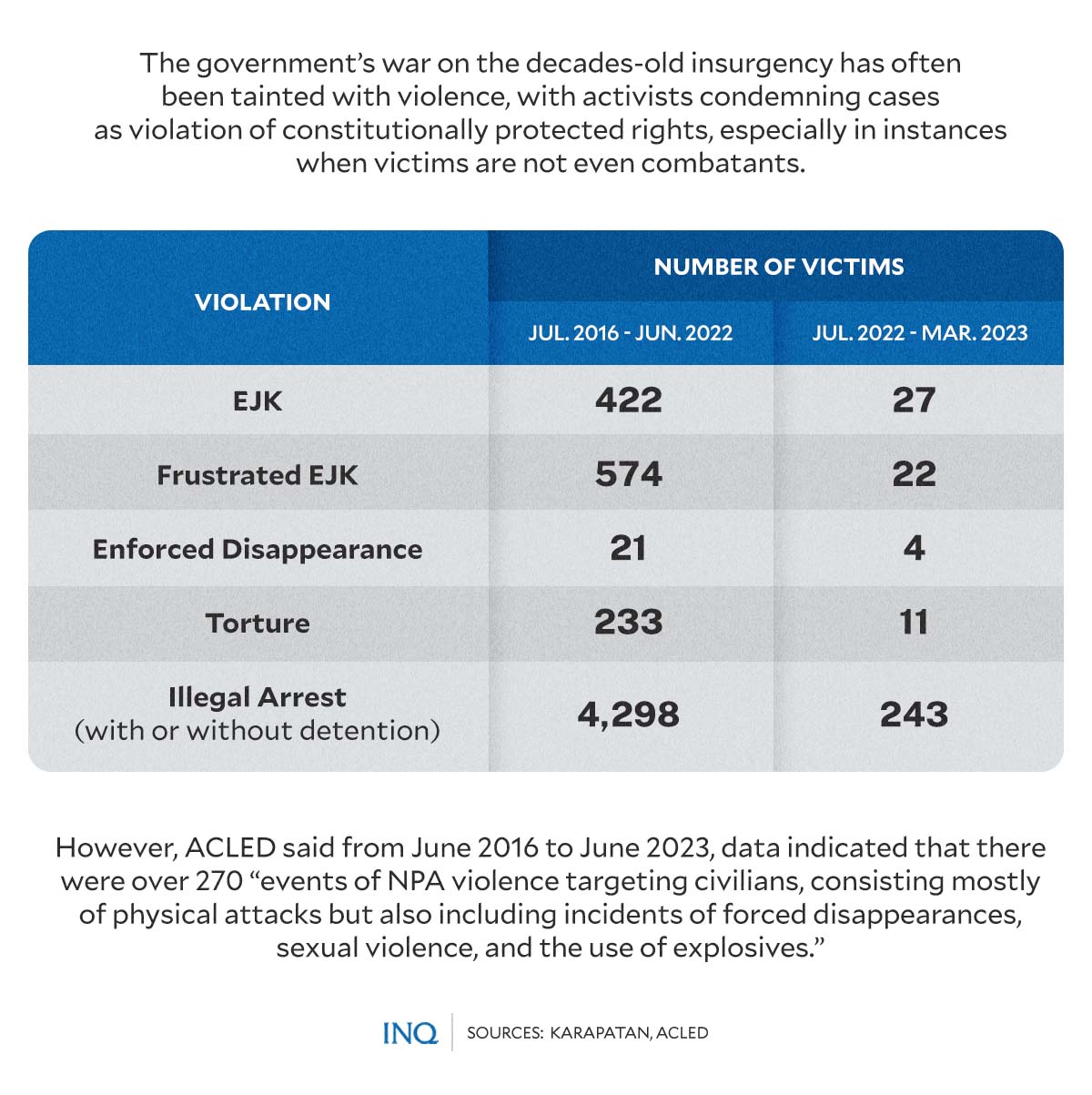No end in sight: Armed conflict in PH seen to persist
MANILA, Philippines—Decades after the over 20-year regime of Ferdinand Marcos Sr. ended, Ferdinand Marcos Jr. was elected president and is now seeking an end to a communist insurgency that started in the first years of his father’s rule.
Looking back, it was in 1968, 1969 and 1973 when the Communist Party of the Philippines-New People’s Army-National Democratic Front (CPP-NPA-NDF) was established as a breakaway group from the Partido Komunista ng Pilipinas.
Existing for over 50 years already, the communist insurgency in the Philippines is still far from over despite the declarations of the government, especially by the military, that the end to the world’s longest armed rebellion is already in sight.
Last March, within the first year of Marcos Jr.’s presidency where officials have asserted that the NPA is already dwindling, Lt. Gen. Romeo Brawner, who was then the chief of the Philippine Army, said the President directed the military to “finish them off now.”
Marcos Jr., who addressed Filipinos for his second Sona last July 24, stressed that for decades, “some of our co-Filipinos have taken to arms to make their views known and felt,” but as he pointed out, “we are now at a point in our history when their armed struggle has evolved.”
Article continues after this advertisement“We have now progressed together towards peace and development. We have incorporated capacity-building and social protection into our reintegration programs to guarantee full decommissioning of former combatants,” he said.
Article continues after this advertisementHowever, activist Teodoro Casiño, who served as representative of Bayan Muna, said “if [Marcos Jr.] is really serious in forging a just and lasting peace, he should be ready to engage with peace advocates and see things from a different perspective.”
‘Nothing has changed’
Casiño told INQUIRER.net via Viber that “the Marcos [Jr.] administration’s approach to the armed conflict follows the same hardline [and] fascist approach as [Rodrigo] Duterte’s.”
Looking back, Duterte, who ruled from 2016 to 2022, was first expected to bring a peaceful end to the communist insurgency because of his relationship with rebel leaders in Davao Region as mayor of Davao City.
But in 2017, it was Duterte himself who signed Proclamation No. 360, which declared the termination of peace negotiations with communist rebels and later declared the CPP and the NPA as terrorists.
As pointed out by the Armed Conflict Location & Event Data Project (ACLED) in a report written by Tomas Buenaventura, Duterte “initially oversaw ambitious peace negotiations before a dramatic about-face toward all-out war.”
It was in 2018 when Executive Order No. 70 was signed to provide a “whole-of-nation” plan to end the over 50-year old armed rebellion. It established the National Task Force to End Local Communist Armed Conflict (NTF-Elcac), which has been criticized for red-tagging activists.
Casiño said the framework, patterned after the US Armed Forces’ counterinsurgency model, “expands the target of […] operations to include civilian communities, groups, and individuals working within the legal, parliamentary arena.”
“It also expands the scope of such operations to include the delivery or denial of government projects and services,” he said, stressing that “in a sense, it reduces governance to a counterinsurgency program.”
“Such an approach shuns peace negotiations as a means of resolving the armed conflict; denies the legitimacy of progressive causes, organizations and movements, most of which end up being vilified and red-tagged,” he said.
Casiño, chairperson of the Bagong Alyansang Makabayan, pointed out that the framework also leads to systematic and widespread violations of human rights and international humanitarian law.
It was during the presidency of Duterte, too, that the highly opposed Anti-Terrorism Act was signed into law, later leading to the designation of the CPP-NPA and the NDF as terrorists by the Anti-Terrorism Council on Dec. 9, 2020 and June 23, 2021.
Dwindling NPA?
The all-out war waged by Duterte to seek an end to the communist insurgency, the government said, has led to the surrender of over 20,000 rebels. Most, however, were eventually questioned as supposedly forced or fake surrenders.
But the military insisted that the NPA is already dwindling, saying that as of July this year, out of 42,046 barangays in the Philippines, the NPA is only present in 200, down from 400.
READ: NPA present in more than 200 barangays, says AFP
The Armed Forces of the Philippines (AFP) also pointed out that the number of existing NPA guerrilla fronts, which should have at least three platoons and 100 armed combatants, already fell to 22, with only one considered “active.”
It said the NPA is now down to 1,800 armed combatants from 2,112 in 2022 and 25,000 in the 1980s. Last April, Jonathan Malaya, assistant director of the National Security Council, told One News that the insurgency will finally end in the next two years.
Despite these declarations, however, the CPP said the NPA currently has 110 guerrilla fronts all over the Philippines, saying that “we must continue to accumulate strength […] to bring the people’s war […] to the next higher level.”
The CPP stressed that “the NPA has adapted to the particular conditions of the country, achieving ‘great successes in carrying out guerrilla warfare, building guerrilla zones and base areas, and establishing Red political power covering vast areas in the countryside’.”
It said they remain completely “determined to carry forward” its protracted people’s war, which involves the gradual encirclement of cities from the countryside, carried out primarily by workers as its leading class and peasants as its main force.
As pointed out in ACLED’s report, while “the endurance of the communist insurgency through several decades is an oft-raised question,” rebels said the NPA’s strength reflects the persistence of the basic societal problems in the Philippines.
By the rebels’ own account, these problems “provide fertile ground for the recruitment of peasants and other supportive classes, such as workers and even students from the cities.
“The strong ideological character of the insurgency seems to ensure an ample supply not only of occasional fighters, but of revolutionaries committed to pursuing their vision for Philippine society long term,” the report stated.
Failing or not?
As Casiño said, Marcos Jr. “must first of all acknowledge that his father’s 20-year rule, 14 years of which was under a dictatorship, not only failed to defeat but even encourage[d] the growth of the armed rebellion.”
“He should also realize that Duterte, who emulated his late father, also failed despite his hardline, militarist approach,” he said, stressing that it should always be about “resolving the roots of the armed conflict.”
Looking back, the government stated in 2019 that the rebellion will end in two years.
READ: CPP-NPA wiped out in 2 years, says DILG chief
ACLED, a US-registered non-profit organization that analyzes information and data on conflicts and violence all over the world, said the NPA is most active in Negros Occidental and Bukidnon, which are in regions known for agrarian unrest.
The provinces, home to thousands of farmers who remain to be the poorest sector in the Philippines, have a 21.8 percent and 29.2 percent poverty rate in 2021, higher compared to the regional poverty incidence of 19 percent and 26.1 percent.
“Western Visayas and Northern Mindanao are both known for agrarian unrest, being two of the country’s most important agricultural centers, and therefore serve as ideal staging grounds for the CPP’s revolution,” the report stated.
Despite the higher levels of fighting between the NPA and state forces in these regions, however, armed clashes between both sides were seen in practically all parts of the country from the start of the regime of Duterte and into Marcos Jr.’s.
“This means that the NPA has been present in every region, mirroring the prevalence of agrarian issues across the country and widespread poverty of agricultural workers,” said the ACLED report.
According to data from ACLED, which conducts analysis to describe, explore, and examine conflict scenarios, the highest level of fighting between the two sides under the Duterte administration was in 2017, when the peace negotiations were terminated.
“Fighting continued largely unabated, with an average of nearly 22 clashes per month between state and rebel forces from February 2017, the end of the ceasefire, to June 2022, the end of Duterte’s regime,” ACLED said.
Confronting adversities
ACLED said in Duterte’s last few months in office, the military leadership aimed to cap his six-year presidency by doing its best to end the insurgency, leading to increased armed clashes.
The trend, it stressed, saw highs in December 2021, the 53rd anniversary of the CPP, and in April 2022, right before May, the month when Marcos Jr. was elected to the presidency.
When Marcos Jr.’s term started, “violent interactions between state forces and the NPA decreased slightly in the latter half of 2022,” especially with the death of two highest-ranking CPP officials Benito and Wilma Tiamzon in August 2022, then Jose Maria Sison at year end.
ACLED data indicated a slight general downward trend in armed interactions between state forces and the NPA in the immediate months following the Tiamzons’ deaths in August 2022.
“Fighting was even more muted in December 2022, the month of Sison’s death,” said ACLED.
However, while the lower volume of fighting in the last few months of 2022 perhaps reflected the immediate aftermath of the Tiamzons’ and Sison’s deaths, possibly indicating weakened communist forces, fighting again rose in the first quarter of 2023.
As pointed out in the report that ACLED released last month, the trend reached a high in March 2023, which saw the largest number of armed clashes between the two sides since December 2018.
It said this “suggests that the rebels might have been able to regroup and re-strategize following their losses in 2022,” adding, however, that this peak in March 2023 was again followed by a downward trend in fighting from April to June 2023.
As stated in the report, the military asserted that Tiamzons’ and Sison’s deaths have created a “leadership vacuum” that “leaves the underground movement without a sense of strategic and operational directions and the reason for its existence.”
But last March, the CPP said “day by day, the seeds of the future people’s democratic government are sown in thousands of villages across the country, existing side by side with an antithesis to the present reactionary and fascist government.”
Dim path
Casiño said resolving “poverty, underdevelopment, oppression and social injustice requires the help and cooperation of everyone, including the armed movement that has repeatedly shown its willingness to engage in peace negotiations for this purpose.”
But as ACLED pointed out, formal peace negotiations between the government and the communist leadership, which have taken place in over 40 rounds since 1986, look unlikely to be revived under Marcos Jr.
“This would make Marcos, Jr. the first Philippine president after the fall of his father’s dictatorship not to seek peace negotiations with the CPP-NPA-NDF,” the US-based group said.
READ: Under Bongbong Marcos, peace talks with Reds ‘dim’– US non-profit
As stated by the Department of Justice, the government may do localized peace talks.
“There would be no more peace talks on the national level. Peace talks will be localized everywhere. That is the advice that I have been getting from our national security agencies that are there,” Justice Secretary Jesus Crispin Remulla had said.
ACLED stressed that in seven years, data showed over 270 events of NPA violence “targeting civilians, consisting mostly of physical attacks but also including incidents of forced disappearances, sexual violence, and the use of explosives.”
However, based on data from Karapatan, the government’s war on insurgents has been tainted with violence, too, with some instances where victims are not even combatants.
From July 2016 to June 2022, it said there were 422 victims of extrajudicial killing (EJK), 574 victims of frustrated EJK, 21 victims of enforced disappearance, 233 victims of torture, and 4,298 victims of illegal arrest, with or without detention.
These, it said, continued as Marcos Jr. came, stressing that from July 2022 to March 2023, there were 27 victims of EJK, 22 victims of frustrated EJK, 4 victims of enforced disappearance, 11 victims of torture, and 243 victims of illegal arrest.
ACLED said the military’s campaign against the communist insurgency has been accompanied by acts of violence targeting civilians, particularly in the context of “red-tagging.”
Casiño said Marcos Jr. himself might not be as foul mouthed and rabid a red tagger as Duterte, but from the vice president down the line, nothing much has changed, stressing that “it is even getting worse.”
Last month, four Cordillera-based activists, including three who asked the Supreme Court to protect them from state-led harassment last month, have been designated as terrorists by the ATC.
READ: 4 Cordillera activists tagged as ‘terrorists’
ACLED said with Marcos, Jr.’s campaign against the communist insurgency bolstered by the vast powers of the NTF-ELCAC, and with the communist insurgency vowing to march on despite recent setbacks, there is really still no end in sight.
READ: ATC’s terrorist tag on Cordillera activists condemned
